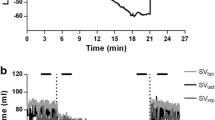Abstract
We have conducted four major impedance cardiography (ZCG) studies to provide data on validity, reproducibility, and sensitivity of response to interventions. The reference technique was quantitative nuclear ventriculography (NVG). Subjects were healthy young men in situations where minimally invasive and unobtrusive techniques were preferred. Interventions used included caffeine ingestion and exercise. Validity of ZCG estimates of stroke volume index (SVI, ml/m2) was tested in 35 men at rest. SVI was 49±9 by ZCG and 46±7 by NVG (r=0.82). Measurements of SVI during bicycle exercise showed no overall difference by the two methods (F=0.26, P=NS). Vascular resistance index (mean BP/CI) increased comparably by both techniques (+9.6% by ZCG and +9.7% by NVG) following caffeine (3.3 mg/kg). The reproducibility of ZCG was demonstrated in the day-to-day consistency of caffeine's effect on vascular resistance in 3 other studies (+11.9%, 12%, and 8.9%). Reliability across and within days was shown by repeated tests in the same subjects (SVI, r's=.96, .92). Conclusion: Impedance cardiography was shown to be a useful noninvasive technique for evaluation of cardiodynamics in biomedical research since it was highly reproducible and yielded equivalent results of relative changes produced by pharmacological and physical challenge. In addition, there was good agreement with NVG in absolute values for grouped data.
Similar content being viewed by others
References
Ashburn, W.L.; Kostuk, W.J.; Karline, J.S.; Peterson, K.L.; Sobel, B.E. Left ventricular volume and ejection fraction determined by radio-nuclide angiography. Semin. Nucl. Med. 3: 165–176; 1973.
Burow, R.D.; Wilson, M.F.; Heath, P.W.; Corn, C.R.; Amil, A.; Thadani, U. Influence of attenuation on radionuclide stroke volume determinations J. Nucl. Med. 23: 781–795; 1982.
Ebert, T.J.; DeMeersman, R.E.; Seip, R.L.; Snead, D.B.; Schelhorn, J.J. Signal-averaged impedance cardiograms during continuous exercise in man. Unpublished manuscript, 1986, VA Medical Center, Milwaukee, WI.
Ebert, T.J.; Eckberg, D.L.; Vetrovic, G.M.; Cowley, M.J., Impedance cardiograms reliably estimate beat-by-beat changes in left ventricular stroke volume in humans. Cardiovasc. Res. 18: 354–360; 1984.
Kisakevitch, P.N.; Gollan, F.; McDermott, J.; Aranda, J. Continuous noninvasive cardiac monitoring of cardiac function. Proc. of the First Annual Symposium on Computer Applications in Medical Care. IEEE:77CH1270-1278C: 325–335; 1977.
Kubicek, W.G.; Kottke, F.J.; Ramos, M.V.; Patterson, R.P.; Witsoe, D.A.; Labree, J.W.; Remole, W.; Layman, T.E.; Schwening, H.; Garamella, J.T., The Minnesota impedance cardiograph — theory and applications. Biomed. Engr. 9: 410–416; 1974.
Lovallo, W.R.; Pincomb G.A.; Sung, B.H.; Sausen, K.P.; Wilson, M.F. Cardiovascular effects of mental stress in men high and low in risk of hypertension. Circulation 76(Suppl II): IV-11; 1987.
Pincomb, G.A.; Lovallo, W.R.; Passey, R.B.; Whitsett, T.L.; Silverstein, S.M.; Wilson, M.F. Effects of caffeine on vascular resistance, cardiac output and myocardial contractility in young men. Am. J. Cardiol. 56: 119–122; 1985.
Pincomb, G.A.; Lovallo, W.R.; Passey R.B.; Wilson, M.F. Effect of behavior state on caffeine's ability to alter blood pressure. Am. J. Cardiol. 61: 798–802; 1988.
Secher, N.J.; Thomsen, A.; Arnsbo, P. Measurement of rapid changes in cardiac stroke volume. An evaluation of the impedance cardiography method. Acta Anaesthes. Scand. 21: 353–358; 1977.
Strauss, H.W.; Zaret, B.L.; Hurley, P.J.; Natarajan, T.K.; Pitt, B. A scintiphotographic method for measuring left ventricular ejection fraction in man without cardiac catheterization. Am. J. Cardiol. 28: 575–580; 1971.
Van Fraechem, J.H.P. Stroke volume and systolic time interval adjustments during bicycle exercise. J. Appl. Physiol. 46: 588–592; 1979.
Wilson M.F.; Lovallo, W.R.; Pincomb, G.A. Noninvasive measurement of cardiac functions. In: Schneiderman, N.; Weiss, S.; Kaufman, P.; eds. Handbook of Research Methods in Cardiovascular Behavioral Medicine. New York: Plenum Press; pp. 23–50; 1989.
Wilson, M.F.; Sung, B.H.; Pincomb, G.A.; McDaniel, K.B.; Lovallo, W.R. Caffeine exaggerates hyptertensive response to maximum exercise in normal young men at risk for hypertension. Circulation 76(Suppl II): IV-11; 1987.
Author information
Authors and Affiliations
Additional information
Supported by funds from the National Heart, Lung, and Blood Institute, HL32050; and the Medical Research Service, Department of the Veterans Affairs.
Rights and permissions
About this article
Cite this article
Wilson, M.F., Sung, B.H., Pincomb, G.A. et al. Simultaneous measurement of stroke volume by impedance cardiography and nuclear ventriculography: Comparisons at rest and exercise. Ann Biomed Eng 17, 475–482 (1989). https://doi.org/10.1007/BF02368067
Received:
Issue Date:
DOI: https://doi.org/10.1007/BF02368067




